The Beringia Park is situated on the Chukchi Peninsula, Russia’s Farthest Northeast. It occupies the territory of two administrative districts of the Chukotka Autonomous Region: the Chukotskii District in the north of the Peninsula and the Providenskii District in the south. The Park’s territory, including its coastal and inner waters, totals 7544704.3 acres.
Relief and Landscape
The physical landscape of the Beringia Park is maritime highland subarctic tundra. The mountains are not very high, about 900 meters. The highest one is the 1194 Iskhodnaya Mt. There are some vast tundra planes.
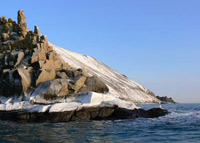 Southeast of the Chukchi Peninsula is a realm of stones. “Kekurs” – conical rock islands of varying heights found here – have been described as mythical and romantic. “Kingdom of Winds” reigns at the mountaintops. The mysterious geophysical formations found throughout look very inviting to someone in search of fortress remains of ancient civilization.
Southeast of the Chukchi Peninsula is a realm of stones. “Kekurs” – conical rock islands of varying heights found here – have been described as mythical and romantic. “Kingdom of Winds” reigns at the mountaintops. The mysterious geophysical formations found throughout look very inviting to someone in search of fortress remains of ancient civilization.
Coastline.
Beringia seashores are indented by gulfs, fiords, and bays. Most easily accessible from the settlements are Provideniya Bay and Gulf of Lavrentiya. There are many sand spits like Kivak, Imtuk, Gatlyangan, Uelen, and Inchoun.
Climate.
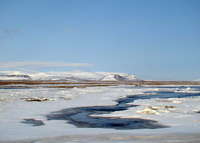 The subarctic maritime climate of the Chukchi Peninsula – with long winters and short, mildly warm, summers – is severer than that in most regions of Alaska. It is not only because of low temperature, but also because of the heavy winds coming from the Bering Sea. Sometimes the wind speed exceeds 40 m p/s, lasting for over a week. The windiest time is usually in the months of October through December.
The subarctic maritime climate of the Chukchi Peninsula – with long winters and short, mildly warm, summers – is severer than that in most regions of Alaska. It is not only because of low temperature, but also because of the heavy winds coming from the Bering Sea. Sometimes the wind speed exceeds 40 m p/s, lasting for over a week. The windiest time is usually in the months of October through December.
Springs are often characterized by heavy fog, dissolved periodically by strong gusts of air. Sometimes the ground gets covered by crust of ice. Long winter snowstorms and scarce warmth make this land difficult to develop.
The weather changes frequently, often several times a day. Atmospheric precipitation is 700 mm in a year.
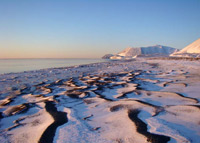
Seasons.
Winter lasts about 8 months, from October through the beginning of May. The lowest temperature is -40 -45 °C. Snow remains on the ground for 210-220 days a year. We have about 100 snowstorms per winter. The average temperature in January and February is -18 -20 °C.
Spring is short, lasting only a month. May is windy, foggy, and often gets visited by hailstorms. The air temperature is about 0°С. Snow begins melting from the middle of May until the beginning of June. The tundra is free from snow to the end of summer, but snowfalls are still possible.
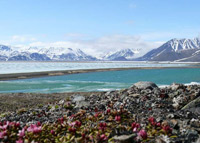 Summer lasts from June until August. It is often foggy, windy, and rainy. But there are sunny and warm days every year. The warmest time is second half of July and early August, with temperatures reaching +5°С to +8°С by the coast and up to +30°С in the tundra; higher temperatures are possible, but rare. The fall is as short as the spring, lasing until about the third week of the September. This time of year does have a share of sunny days with cool, crispy air, but is also frequented by overcast, fog, and precipitations like drizzle or freezing rain. First snowfall at mountaintops and frost groundcover commonly arrive in early September. October temperature is usually around -5°C.
Summer lasts from June until August. It is often foggy, windy, and rainy. But there are sunny and warm days every year. The warmest time is second half of July and early August, with temperatures reaching +5°С to +8°С by the coast and up to +30°С in the tundra; higher temperatures are possible, but rare. The fall is as short as the spring, lasing until about the third week of the September. This time of year does have a share of sunny days with cool, crispy air, but is also frequented by overcast, fog, and precipitations like drizzle or freezing rain. First snowfall at mountaintops and frost groundcover commonly arrive in early September. October temperature is usually around -5°C.
Freshwater Systems.
The Park’s territory lies within an extensive network of rivers, lakes of different geological histories, and vast territories of ice cover forming in wintertime. The rivers are fed by snow and rain, flooding high during springtime, receding in summer and fall, and freezing to the bottom in wintertime. Among the largest rivers are Chegitun’, Loren, Marich, Kurupka, and Sineveem. The lakes include both, large mountain lakes such as Ionii and Koolen’ and lagoons such as Achchen, Imtuk, and Istikhed.
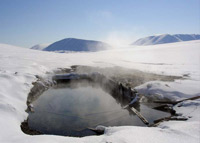
Hot Springs.
There are currently nine groups of geothermal springs that have been documented within the Park’s territory. These include Chaplino Hot Springs (temperature at ground level +87.5°С), Seniavin Hot Springs (+79.7°С), Arakamchechen (+38°С), and Kivak Hot Springs (+43°С) in the Providenskii Districts and Lorino Hot Springs (+58°С), Mechigmen Hot Springs (+97°С), Tumannyie (“Foggy”) Hot Springs (+56°С), Bezymiaannyie (“No Name”) Hot Springs (+21°С), and Dezhnev Hot Springs (+59.5°С) in the Chukotskii District.
